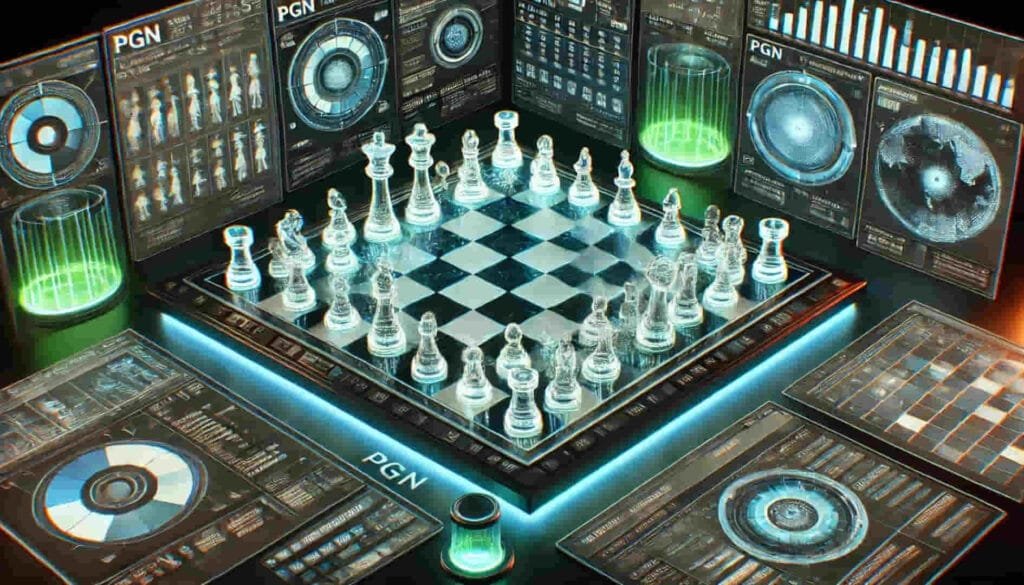App to Convert Chess PGN Database into Graphs
Introduction
Chess is one of the oldest and most revered games in the world, with a rich history spanning centuries and cultures. Over the years, the way players analyze and study chess has evolved significantly, and one of the most important tools in this process has been the PGN chess database. But what exactly is a PGN chess database, and how can it be used to generate graphs that facilitate game analysis and trend identification?
Portable Game Notation (PGN) is a standard text format used to record and share chess games. This format was developed in 1993 by Steven J. Edwards and has since become the standard for storing chess game data. A PGN file contains essential game information, including player names, game date, location, and a sequential list of all moves made during the game.
Analyzing chess games using PGN databases is a common practice among players and coaches at all levels. These files not only allow players to review and study historical games but also help identify patterns and trends in a player’s game or a group of players. However, simply reviewing games in text format can be tedious and limited in its ability to reveal useful information at a glance. This is where data visualization comes in.
Generating graphs from PGN database data allows users to obtain a clear and concise visual representation of game results and patterns. Graphs can illustrate a variety of metrics, such as a player’s performance over time, the frequency of certain openings, or relative success in different game phases. These visualizations not only make data easier to understand and analyze but also make results more accessible and appealing to a broader audience.
In this article, we will explore how to create an application that converts chess PGN database data into informative and useful graphs. We will detail each step of the process, from setting up the development environment on Windows to compiling the necessary code. We will also provide specific command examples and code snippets to guide readers through the process. Finally, we will discuss the importance and impact of these graphs on chess analysis.
What Are Score or Result Graphs from a PGN Chess Database?
Before diving into creating our application, it is crucial to understand what types of graphs can be generated from PGN database data and how these graphs can be interpreted to gain valuable insights.
Types of Graphs
- Performance Graphs:
- Line Graphs: Show a player’s performance over time by plotting their scores in different games.
- Bar Graphs: Compare a player’s performance across different periods or tournaments.
- Opening Graphs:
- Pie Charts: Illustrate the frequency of different openings used by a player.
- Bar Graphs: Show the relative success of different openings.
- Game Phase Graphs:
- Scatter Plots: Show how a player’s performance varies across different game phases (opening, middlegame, endgame).
- Radar Charts: Compare multiple performance variables across different phases.
Examples of Existing Tools
Tools like pgnstats and pgnToScores have demonstrated how chess game data can be converted into useful graphs.
pgnstats:
- This tool analyzes PGN files and generates statistics on games. It provides data that can be used to create detailed graphs on player performance and game trends.
pgnToScores:
- This tool converts PGN files into scores that can then be graphed. It facilitates the creation of graphs showing player performance over time and the success of different strategies and openings.
Interpretation of Graphs
- Performance Over Time: These graphs allow players and coaches to see how a player’s performance has evolved over different periods. They can reveal improvement or decline trends, as well as identify periods of stability.
- Opening Frequency and Success: By visualizing which openings are used most frequently and their success rates, players can adjust their strategies and better prepare against specific opponents.
- Game Phase Analysis: Comparing performance across different game phases can help identify strengths and weaknesses. For example, a player may excel in the opening but struggle in the endgame.
In summary, graphs generated from PGN database data not only make information more accessible and easier to understand but also provide a powerful tool for strategic analysis and performance improvement in chess. Now, let’s move on to setting up the Windows environment to create our application.

Setting Up the Windows Environment
To develop an application that converts PGN database data into graphs, we need to set up a proper development environment on Windows. This process includes installing Python and other necessary tools and libraries for development and code compilation. Below are the steps required to set up the environment on Windows 10 Pro.
Installing Python
Python is a versatile and powerful programming language, ideal for developing data analysis and graph generation applications. Below are the steps to install Python on Windows 10 Pro:
- Download the Python Installer:
- Visit the official Python website (https://www.python.org/).
- Download the latest Python version for Windows. Ensure you download the installer compatible with your Windows version (32-bit or 64-bit).
- Install Python:
- Run the downloaded installer.
- Select the “Add Python to PATH” option to ensure Python is accessible from the command line.
- Click “Install Now” to start the installation.
- Once the installation is complete, verify it by opening a command window and running
python --version. You should see the installed Python version.
- Install Additional Libraries:
- Open a command window and run the following commands to install the necessary libraries for our application:
pip install pandas matplotlib seaborn
- Open a command window and run the following commands to install the necessary libraries for our application:
Installing Clang and Windows Subsystem for Linux (WSL)
To compile certain dependencies, we may need additional tools like Clang and the Windows Subsystem for Linux (WSL).
- Enable WSL:
- Open PowerShell as Administrator and run:
wsl --install - Restart your computer if required.
- Open PowerShell as Administrator and run:
- Install Clang:
- Open a WSL terminal and run:
sudo apt update && sudo apt install clang
- Open a WSL terminal and run:
Compiling and Running Code
To process PGN files and generate graphs, we will use pgnToScores. Below are the commands to compile and run it:
- Clone the repository:
git clone https://github.com/chris13300/pgnToScores.git cd pgnToScores - Compile the code:
make - Run the tool:
./pgnToScores input.pgn output.csv
This will generate a CSV file that can be used to create graphs in Python.
Conclusion
The ability to visualize PGN chess database data through graphs significantly enhances the way players and analysts interpret chess statistics. By using tools like pgnToScores and pgnstats, combined with Python libraries like Matplotlib and Seaborn, we can generate informative graphs that offer insights into player performance, opening effectiveness, and trends over time.
With the correct setup on Windows, developers can create an application that automates this process, making chess analysis more accessible and engaging. Whether for professional training or personal improvement, graphical representations of chess data provide a clearer picture of performance and strategies.
References

Jorge Ruiz Centelles
Filólogo y amante de la antropología social africana